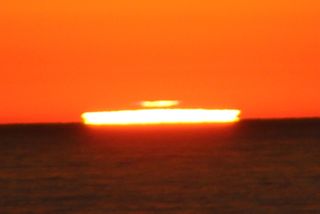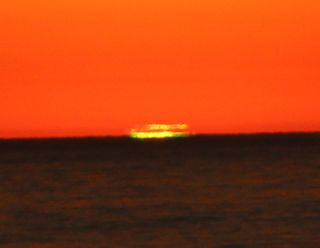
A bit of patience and persistence paid off beautifully for one astrophotographer who captured not one, but two solar green flashes while recently observing a sunset off Solano Beach, Calif.
Night sky photographer Josh Knutson took these images on Oct. 27, 2012. The photos and video were captured using a Canon T3i and 300mm EF lens at F/10, 1/800 sec, ISO100 for the still images, and auto settings were used for the video.
After three evenings without success, Knutson was rewarded on his fourth try.
“As chance would have it I captured two green flashes in one sunset, within a fraction of an instant of each other. They lasted maybe a second or two each. It was an amazing sight to see, even if only for a brief moment.” Knutson wrote in an email.

“I've waited a long time for the opportunity to see a green flash—something that's nearly impossible from New Mexico, where I live.”
The two hesitations in the video during the green flashes—the first at 25 seconds and the second at 40-41 seconds—are from Knutson using his Canon T3i while capturing in video mode, then using the frame capture ability to snap still shots while running a video sequence.
A striking but momentary green flash can often be observed above the rising or setting sun and is caused by refraction of light in the atmosphere. Earth’s atmosphere works similar to a prism breaking up white light into colors. The colors of the spectrum disappear one at a time, going in order of those with the longest wavelengths to those with the shortest, making green the last ray of light that can be seen.
Get the Space.com Newsletter
Breaking space news, the latest updates on rocket launches, skywatching events and more!
Editor's note: If you have an amazing skywatching photo you'd like to share for a possible story or image gallery, please contact managing editor Tariq Malik at tmalik@space.com.
Follow SPACE.com for the latest in space science and exploration news on Twitter @Spacedotcom and on Facebook.
Join our Space Forums to keep talking space on the latest missions, night sky and more! And if you have a news tip, correction or comment, let us know at: community@space.com.
Nina Sen is a freelance writer and producer who covered night sky photography and astronomy for Space.com. She began writing and producing content for Space.com in 2011 with a focus on story and image production, as well as amazing space photos captured by NASA telescopes and other missions. Her work also includes coverage of amazing images by astrophotographers that showcase the night sky's beauty.
